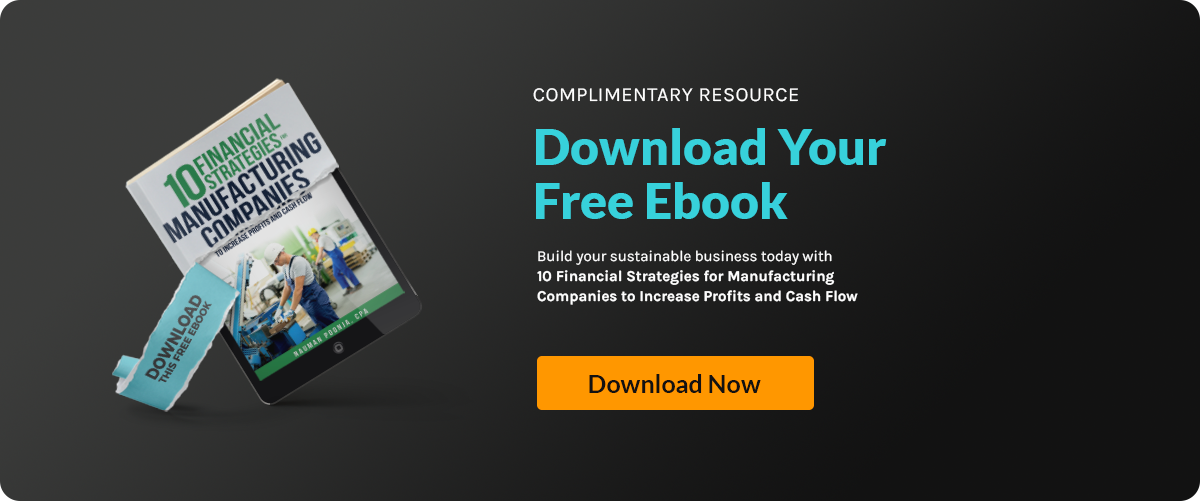How Rolling Forecasting Gives Manufacturers a Competitive Edge

In the fast-paced manufacturing world, staying ahead of the curve is not just an advantage; it's a necessity. Companies that use rolling forecasts can forecast revenue within +/- 5% accuracy. These forward-looking businesses can dynamically anticipate market changes, adjust their strategies, and maintain a competitive edge.
Now, ask yourself: Is your current forecasting method setting you up for success, or is it time for a change? Dive into our blog to discover how rolling forecasting could be the strategic upgrade your manufacturing process needs.
What is Rolling Forecasting?
Rolling forecasting is a dynamic financial planning tool that offers manufacturers a competitive advantage. Unlike a traditional budget, which remains static for the fiscal year, a rolling forecast is continuously updated throughout the year. This flexible approach allows businesses to adjust their financial plan based on current data and market conditions.
By implementing a rolling forecast, manufacturers can regularly update their forecast period, ensuring they respond quickly to changes and make more informed decisions. This ongoing budget process helps maintain financial agility and improve overall business performance.
Ensuring Financial Stability
Ensuring financial stability is critical for manufacturing success. By integrating effective financial forecasting practices, manufacturers can make informed business decisions that support long-term growth.
Here are seven ways to ensure financial stability in manufacturing.
1. Adopt a Rolling Forecast
Transitioning from a traditional approach to adopting a rolling forecast enhances forecast accuracy. This method allows for continuous updates and adjustments to the current forecast based on real-time data.
2. Implement Best Practices
Following the best practices helps maintain a robust planning process. Regularly updating revenue and expense forecasts ensures the financial plan remains relevant and accurate.
3. Analyze Market Conditions
Understanding the company’s sensitivity to market conditions is crucial. Internal and external factors should be considered when updating forecasts to reflect true market dynamics.
4. Enhance Forecast Accuracy
Utilize advanced financial forecasting tools to improve the accuracy of your forecasts. Accurate forecasts help in making reliable business decisions and maintaining market share.
5. Evaluate Forecasts Regularly
Regularly review and assess new forecasts to ensure they align with business objectives. This ongoing evaluation helps in identifying potential risks and opportunities early.
6. Communicate Across Departments
Ensure that financial forecasting involves input from various departments. This holistic approach guarantees that all aspects of the business are considered in the planning process.
7. Leverage Internal and External Data
Incorporate both internal financial data and external market trends into your forecasting. This comprehensive approach enhances the reliability of the forecast and supports better decision-making.
Streamlining the Forecasting Process
Streamlining the forecasting process is essential for manufacturers to maintain accuracy and efficiency. By transitioning to a rolling forecast, manufacturing businesses can better manage their financial planning and analysis.
Here are five ways to streamline the forecasting process in manufacturing.
Adopt Rolling Forecasts Over Static Budgets
Transitioning from a static budget to a rolling forecast allows for continuous updates. This ensures that your forecast shows the most current financial data, providing a clearer picture of where the money is moving.
Automate the Forecasting Process
Implementing automation in the rolling forecast process reduces manual errors and saves time. Automation helps the finance team focus on strategic planning and analysis rather than repetitive tasks.
Shorten the Time Horizon
Use a 12-month rolling forecast to maintain a consistent and updated view of financial performance. This shorter time horizon allows for more frequent adjustments, improving forecast accuracy.
Integrate Forecasting with Budgeting
Combining budgeting and forecasting into a single rolling forecast model streamlines financial planning. This integration ensures that the budget reflects real-time data and adjusts to changes in the business environment.
Collaborate Across Departments
Involving different departments in creating and updating rolling forecasts ensures comprehensive input. This collaboration enhances forecast accuracy and aligns them with overall business objectives.
Empowering Businesses for Sustained Financial Health
Empowering businesses for sustained financial health requires a strategic approach to financial planning. Using rolling forecasts, companies can maintain a flexible and responsive financial strategy.
Here are seven key strategies to ensure sustained financial health.
1. Utilize Rolling Forecasts
Transition from an annual budget to rolling forecasts to continuously update financial plans. This shift allows for adjustments based on real-time data, enhancing financial accuracy and responsiveness.
2. Leverage Historical Data
Use historical data to build a rolling forecast. By analyzing past performance, businesses can create more accurate and realistic forecasts for future periods.
3. Extend Forecast Horizons
Consider longer forecast horizons, such as 18 or 24 months. This approach provides a broader view of financial trends and helps in long-term planning.
4. Adjust Original Budgets
Regularly update the original budget using insights from rolling forecasts. This ensures that the budget remains relevant and aligned with current business conditions.
5. Enhance Decision-Making
Rolling forecasts can help improve decision-making by providing up-to-date financial information. This empowers management to make informed choices that support sustained growth.
6. Incorporate Cross-Departmental Input
Involve multiple departments in the forecasting process. This collaboration ensures forecasts use comprehensive data and reflect the organization's needs.
7. Monitor and Adapt
Continuously monitor the performance against the rolling forecast. Adapt strategies as needed to address any deviations and capitalize on new opportunities.
Creating an Effective Rolling Forecasting Approach
Creating a practical rolling forecasting approach involves several key steps to ensure accuracy and responsiveness. By embracing rolling forecasts, businesses can enhance their financial planning and stay agile in a dynamic market.
Here are ten steps to create a practical forecasting approach.
Step 1: Understand the Basics
Learn the difference between rolling forecasts and the traditional budgeting process. Recognizing how this forecasting provides continuous updates will help in the transition.
Step 2: Set Clear Objectives
Define what your rolling forecast needs to achieve. This includes understanding your financial goals and the specific outcomes you want to drive.
Step 3: Determine the Forecast Period
Decide on the periods on a rolling basis, such as monthly or quarterly updates. This helps in keeping the forecast current and relevant.
Step 4: Use Historical Data
Leverage past performance data to inform your forecast. This makes the predictions more accurate and realistic.
Step 5: Incorporate Multiple Scenarios
Include various scenarios in your forecast to see how the estimates can adapt to different market conditions. This flexibility helps you better prepare for uncertainties.
Step 6: Automate Where Possible
Use software tools to automate the forecasting process. Automation reduces errors and saves time, making the process more efficient.
Step 7: Regularly Adjust the Forecast
Continuously update the forecast to reflect new information and changes in the business environment. This ensures that your forecast remains relevant.
Step 8: Integrate Across Departments
Ensure that all relevant departments are involved in the forecasting process. This comprehensive approach provides a holistic view of the business.
Step 9: Train Your Team
Educate your finance team and other stakeholders on rolling forecasts. Training ensures everyone understands the process and can contribute effectively.
Step 10: Monitor and Review
Review the performance of your rolling forecast regularly. Adjust the forecast to stay aligned with your business objectives and market conditions.
Stay Ahead of the Curve—Gain a Competitive Edge with Rolling Forecasting by Accounovation
Relying on a static annual budget in the manufacturing industry can be risky. Implementing rolling forecasts allows you to adapt to changes and make informed decisions throughout the year. Imagine having the flexibility to adjust your plans as new data comes in—now that's a game-changer!
At Accounovation, we specialize in helping businesses implement successful rolling forecasts. Our expertise ensures that your financial planning is always up-to-date and aligned with your goals.
Ready to set your business on the path to success? Contact Accounovation today and see how rolling forecasts can give you the needed edge!
Frequently Asked Questions
How can dynamic financial planning help manufacturers stay competitive?
Dynamic financial planning, including variance analysis and budget creation, allows manufacturers to quickly adapt to market changes, allocate resources more effectively, and make informed decisions, ensuring they remain agile and competitive.
What are the benefits of using continuous budgeting for manufacturers?
Continuous budgeting helps manufacturers by providing up-to-date financial insights, improving accuracy in budgeting and forecasting methods, enhancing flexibility, and enabling better alignment with strategic goals through tools like a 12-month forecast.
How does adaptive planning contribute to a manufacturer's success?
Adaptive planning, a management tool that allows manufacturers to set time-specific financial goals, contributes to success by enabling them to respond swiftly to market fluctuations, anticipate potential challenges, and seize new opportunities, thus maintaining a competitive edge.
Why is ongoing financial review critical for manufacturing businesses?
Ongoing financial review is important because it ensures manufacturers have the latest financial data, aiding in better decision-making, resource allocation, and long-term strategic planning. Smart money is moving toward companies that effectively use variance analysis to stay competitive.
How does proactive financial management enhance a manufacturer's competitiveness?
Proactive financial management enhances competitiveness by allowing manufacturers to stay ahead of market trends, optimize their operations, and strategically plan for future growth. This includes creating a budget and using continuous budgeting and forecasting methods, leading to sustained success.





.png?height=200&name=2%20(1).png)

